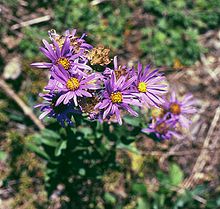Aster amellus
| Aster amellus | |
|---|---|
 |
|
| Scientific classification | |
| Kingdom: | Plantae |
| (unranked): | Angiosperms |
| (unranked): | Eudicots |
| (unranked): | Asterids |
| Order: | Asterales |
| Family: | Asteraceae |
| Tribe: | Astereae |
| Genus: | Aster |
| Species: | A. amellus |
| Binomial name | |
|
Aster amellus L. |
|
Aster amellus, the European Michaelmas-daisy, is a perennial herbaceous plant of the genus Aster, belonging to the Asteraceae family. In the language of flowers, the Michaelmas-daisy symbolizes a farewell or a departure.
The genus name (Aster) comes from the Greek and means "star-shaped flower." The specific name (amellus) is first used in the Georgics (Book IV, 271-280), a poem of the Latin poet Publius Vergilius Maro (70 BC - 19 BC), but the etymology is obscure and uncertain.
Aster amellus reaches on average a height of 20–50 centimetres (7.9–19.7 in). The stem is erect and branched, the leaves are dark green. The basal leaves are obovate and petiolated, the cauline ones are alternate and sessile, increasingly narrower and lanceolate. The flowers are lilac. The flowering period extends from July through October. The hermaphroditic flowers are either self-fertilized (autogamy) or pollinated by insects (entomogamy). The seeds are an achene that ripens in October.
This plant is present on the European mountains from the Pyrenees and the Alps to the Carpathians. Outside Europe it is located in western Asia (Turkey), the Caucasus, Siberia and Central Asia (Kazakhstan).
Asters are valued in the garden for the fact that they provide late summer and autumn colour in shades of blue, pink and white. This species has several cultivars of ornamental garden use. The following have gained the Royal Horticultural Society's Award of Garden Merit:-
...
Wikipedia
